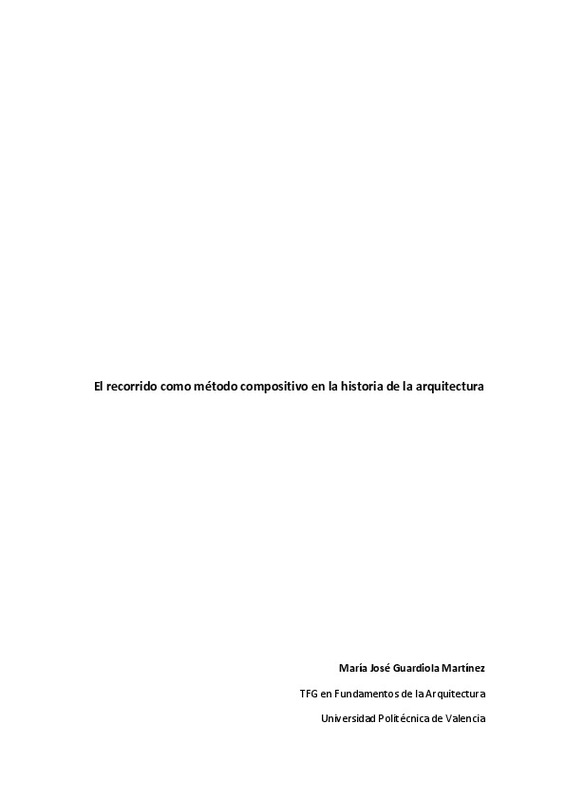|
Resumen:
|
[ES] Al modificar los significados del espacio atravesado, el recorrido se convirtió en la primera acción estética que penetró en los territorios del caos, construyendo un orden nuevo sobre cuyas bases se ...[+]
[ES] Al modificar los significados del espacio atravesado, el recorrido se convirtió en la primera acción estética que penetró en los territorios del caos, construyendo un orden nuevo sobre cuyas bases se desarrolló la arquitectura de los objetos colocados en él.Andar, aunque no siempre es esta la forma de llevar a cabo un recorrido, es un arte que contiene en su seno el menhir, la escultura, la arquitectura y el paisaje. A partir de este simple acto se han desarrollado las más importantes relaciones que el hombre ha establecido con el territorio.La transhumancia nómada, considerado por lo general como el arquetipo de cualquierrecorrido, constituye en realidad un desarrollo de las de las interminables batidas de caza del paleolítico, cuyos significados simbólicos fueron traducidos por los egipcios por medio del ka, el símbolo del eterno errar. El errar primitivo ha continuado vivo en la religión (el recorrido en tanto que mito) así como en las formas literarias ( el recorrido en tanto que narración) , transformándose de ese modo en recorrido sagrado, danza, peregrinación o procesión. Sólo en el siglo XX, al desvincularse de la religión y la literatura, el recorrido ha adquirido el estatuto de puro acto estético.Y es en pleno siglo xxi donde se enmarca nuestra investigación, una vez definidos los recorridos a través de los arquetipos de la historia de la arquitectura.Actualmente contamos con una clasificación clara del recorrido como método compositivo en la historia de la arquitectura, aquel que concibe la circulación, como el hilo perceptivo que vincula los espacios de un edificio o que reúne cualquier conjunto de espacios interiores o exteriores.En su libro Forma, Espacio y Orden. Francis D.K. Ching resume los componentes fundamentales de los sistemas de circulación de un edificio, en cuanto a elementos positivos que influyen en la percepción relativa a formas y espacios constructivos. ParaD.K. Ching estos elementos son: 1. Aproximación al edificio, 2. Acceso al edificio, 3. Configuración de recorridos, 4. Relaciones recorrido-espacio y 5. Forma del espacio de circulación.Nos detendremos en aquellos elementos que utilizaremos posteriormente como características definitorias de los distintos tipos de recorrido.
[-]
[EN] By modifying the meanings of the space traversed, the route became the first aesthetic action that penetrated the territories of chaos, building a new order on whose bases the architecture of the objects placed in it. ...[+]
[EN] By modifying the meanings of the space traversed, the route became the first aesthetic action that penetrated the territories of chaos, building a new order on whose bases the architecture of the objects placed in it. Although it is not always this way to carry out a tour, walking is an art that contains in its bosom the menhir, sculpture, architecture, and landscape. From this simple act, the most important relationships that man has established with the developed territory. The nomadic transhumance, generally considered as the archetype of any route, is a development of those of the endless hunting raids of the Paleolithic. The Egyptians translated their symbolic meanings through the ka, the symbol of eternal wandering. Primitive wandering has remained alive in religion (the journey as a myth) and literary forms (the journey as a narrative), thus transforming itself into a sacred journey, dance, pilgrimage or procession. Only in the 20th century, by disassociating itself from religion and literature, has the route acquired the status of a pure aesthetic act. Our research is framed in the 21st century, once the roads have been defined through the archetypes of the history of architecture.
We currently have a precise classification of the route as a compositional method in the history of architecture, conceiving circulation as the perceptive thread that links the spaces of a building or that brings together any set of interior or exterior spaces. In his book Form, Space and Order. Francis D.K. Ching summarizes the fundamental components of a building's circulation systems in terms of positive elements that influence the perception of building forms and spaces. ForD.K. Ching, these elements are 1. Approach to the building, 2. Access to the building, 3. Route configuration, 4. Route-space relationships and 5. The shape of the circulation space. We will dwell on those elements that we will later use as defining characteristics of the different types of the itinerary.
[-]
|








